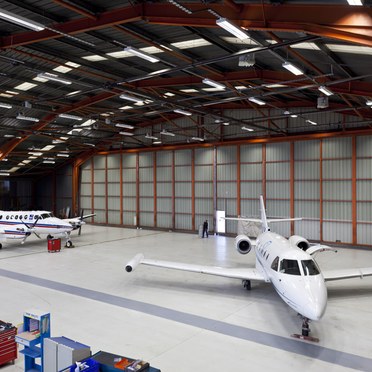PORT LOTNICZY TULUZA-BLAGNAC, FRANCJA
- Lamp efficacy
Lamp efficacy
Ensuring the lamp efficiently converts electricity into light (lm/W).
- Ballast classification
Ballast classification
Controlling the electricity supply to the lamp (Energy Efficiency Index).
- Luminaire distribution
Luminaire distribution
Controlling light emission using optics which bend and shape the light to the correct location.
- System efficacy
System efficacy
Combining optical and thermal control within the luminaire (luminaire lm/W).
- Presence/absence detection
Presence/absence detection
Providing lighting only when it’s needed.
- Daylight detection
Daylight detection
Reducing waste light during daylight hours.
- Constant illuminance
Constant illuminance
Producing the correct lighting levels for the duration of the maintenance period.
- Task-scene setting
Task-scene setting
Allowing the user to set scenes and adapt the lighting to different tasks.
- Timed off
Timed off
Automatic cut-off to turn all lights off during unoccupied hours.
- Task lighting
Task lighting
Lighting task areas with the correct amount of light.
- Zoning of lighting
Zoning of lighting
Zoning lighting in accordance to occupancy patterns or window location.
- Maintenance schedule
Maintenance schedule
Tailoring maintenance schedules in accordance to product age, performance and environment.
- Waste light
Waste light
Eliminating waste light which does not hit the intended target.
- Reflectance
Reflectance
Taking advantage of light which is reflected from the surface within the space.
- Visible smart metering
Visible smart metering
Enabling results of actions to be quickly seen as increased or decreased energy use to encourage responsible energy consumption.
Hi-Rack unosi się wysoko w Porcie Lotniczym Tuluza-Blagnac
Oprawy Hi-Rack oświetlają ten hangar w Międzynarodowym Porcie Lotniczym Tuluza-Blagnac w południowo-zachodniej Francji. Każda z 90 ściemnianych opraw mieści cztery wysokowydajne świetlówki T16 (T5) o mocy 80W. Zapewniają one natężenie oświetlenia na poziomie około 750 lx przy 2 metrach.
Produkty te zostały wybrane, ponieważ technicy odpowiedzialni za konserwację samolotów muszą ciągle identyfikować kable i części elektryczne na podstawie ich koloru i potrzebują równomiernego oświetlenia i dobrej wydajności kolorystycznej.
Inżynierowie są zachwyceni oprawami, podobnie jak władze lotniska, które doceniają ich niższe koszty eksploatacyjne. Wykorzystanie integralnych czujników połączonych z układem sterowania oświetleniem SensaModular umożliwiło im jeszcze większe obniżenie kosztów energii w porównaniu z tradycyjnymi wiszącymi lampami wyładowczymi dużej intensywności.

